THE UFOS THAT NEVER WERE:
CLASSIC PHOTOS NOW EXPOSED AS FAKES!
(originally published Oct 2010)

If researchers are genuine in their quest to find truth in the UFO phenomena, they must be prepared to accept when cherished UFO "evidence" turns out to be the result of fraud. Such is the case with some very famous flying saucer photos from the early years that are forever emblazoned in many of our memories. They have appeared in countless books and magazines and today on numerous websites. They have continued to keep our minds in wonder over the decades. But we need not wonder any more about four pieces of such "photographic evidence."
It can now be revealed that the world-famous Rex Heflin Photos, the Cumberland "Spaceman" Photo, the Zanesville, Ohio barber's photos, and the William Rhodes 1947 photos were all hoaxes.
THE COMPULSION TO PRANK: THEN AND TODAY

Frame from 2007 "Haiti UFO" CGI Hoax Video
Just as many YouTube UFO videos today are made by pranksters, the compulsion to prank in a similar way was evident in the 1940s, 50s and 60s. Now such hoaxes utilize cutting-edge digital technologies such as Paintbox, various CGI programs and other interactive drawing and special effects tools that create highly realistic videos and photos. In earlier days such things as double exposures, overlays, forced perspective – and simply tossing or suspending objects in the air – were used to create equally highly realistic UFO photo effects. Though the technologies are more advanced today, the ingenuity and creativity of earlier UFO picture hoaxers was just as great – and perhaps even greater – than those of today's hoaxers.
RECONCILING BELIEF IN ET AND THE EXPOSURE OF FRAUD
Like many readers will soon feel, I do not like this story. I do not like to report it. I am not driven to "debunk." I am driven to truth. Just as my Socorro UFO hoax expose' was not something that I enjoyed relating in my article series, it pains me to reveal other fraud when found. But we must do so. As readers know, I support the ET nature of many UFOs, including the ET nature of the Roswell crash event. The phenomena is real.
But we must be mature enough to recognize that were there is truth, there are often lies. We must vet. We must not be rabid skeptics, but rather we must be "critical thinkers" in the truest sense. We must "discern the spirits" and evaluate individually all photographic UFO claims. It strengthens our case when we "separate the wheat from the chaff." We are obligated to do so. So many outstanding and credible sightings and other evidence exists supporting ET, that we can "take it" when some treasured UFO stories are proven false or put into serious question. We can then concentrate on the more credible cases, which are infinitely more interesting. The study of UFOs should reflect a process of "continuous improvement." As we learn more about some of the older cases, we must apply newly acquired information and technologies to re-evaluate them. It is our duty to history. Truth must triumph, even when it hurts.
THE ZANESEVILLE, OHIO BARBER'S PHOTOS



As I opened the pages of Ideal's UFO Magazine as a very young child in the 1970s my heart stopped when I saw the series of photos above. Astonished, I thought to myself that here at last was clear proof that we were being visited by others. What else could it be?
On November 13 1966, barber Ralph Ditter photographed a UFO at different angles that appeared outside his house in Roseville, Ohio, a suburb of Zanesville. Ditter exhibited his photos in his barber shop. Some time later the photos were featured in a local paper. Since then, the photos have been carried in books and magazines worldwide. They are most always presented as authentic, or at least as "unresolved." Initially cooperative with official investigators, Ditter later failed to respond to requests for "clarification" of the differences between his account of the sighting and the apparent facts.
But the very little known fact is that Ralph Ditter did indeed confess to a hoax a long time later. Ditter had told MUFON researchers Warren B. Nicholson and Ronald Fisher the truth about the matter on the morning of October 23 1971, a full five years after the photos were taken. This author has recently located and interviewed Warren Nicholson. It was learned that:
Nicholson had arrived with Fisher at Ditter's barbershop unannounced and proceeded to get a haircut. After the cut, Nicholson then handed Ditter a technical report that had conclusively determined through a scientific photo analysis that Ditter's photos were faked. The numbers on the backs of the photos were out of sequence to Ditter's story. The object was really 3-4 inches in diameter and it was only 3-4 feet from the camera lens. The photos were not taken in rapid succession as Ditter had reported, as surrounding scenery had changed (see if you can spot the differences in the photos).
Ditter read the report that had analyzed his photos. Nicholson then asked of Ditter, "Well, what do you think of it?" Ditter replied, "Well, I am the one who faked them. What do you think?" Ditter then made a full confession to the researchers: About a year prior to the photos being made, his young daughter had asked him about the subject of UFOs. In her naive sweetness, the child wanted to know if Ditter could ever find a UFO and take a picture of it for her saying, "Daddy, will you take a UFO picture for me?" Ditter told the researchers he made a promise to her and had said to her, "Yes, someday I will."
A few months later Ditter was cleaning up and repairing his daughter's toy wagon. He had noticed how much the wagon hubcaps were so similar in appearance to the UFO photos that he had seen in men's magazines at the shop like Saga and Argosy. He removed the hubcaps and wire brushed them. He faked the photos for her and put them up in his barbershop. Some months later a customer contacted the media, and the event spiraled out of control. The love for a daughter had inspired Ditter – and we loved Ditter for doing it. The photos enchanted. But it is now time to recognize that they were "pretend." Nicholson explained to me that he and Ronald Fisher had reported this Ditter confession in 1971 and that the article was thought to have been later published in the MUFON Ohio Journal. For some reason, it never made a "blip."
But even this episode of fraud can yield some previously unknown truth. Nicholson explained that the "technical report" on the Ditter photos that Nicholson had presented to the barber had been completed by none other than the the government think-tank the RAND Corporation. Readers will remember my prior investigation revealing that RAND's involvement in UFO investigation is far deeper than has ever been realized. The RAND-UFO story is related in the article Deep Secrets of a UFO Think Tank Exposed (archived on this site). RAND has been secretly involved in official UFO analysis on behalf of the US government for a very long time.
THE CUMBERLAND "SPACEMAN" / SOLWAY FIRTH PHOTO

On the spring day of May 23, 1964 a firefighter named Jim Templeton took his daughter to bucolic Burgh Marsh overlooking Solway Firth in Cumberland, eight miles west of their home in Carlisle in Northern England. John was an amateur photographer. He wanted to take photos of his daughter Elizabeth on that splendid day, and he posed her sitting in an open grass hill area. Some days later Jim went to get his photos back from the photo developer at the local "chemist" shop. Appearing in the photo (but unseen at the time) was a startling figure that seemed for all the world to be that of a strange and small Spaceman! What we would now call an ethereal "Buzz Lightyear" space ranger was perched upon the girl's shoulder!
In the earliest retellings of the event though, Templeton had said something in passing that in later years has somehow been forgotten or gone unnoticed by researchers: The man who developed the photo had remarked to Templeton that "it was a shame that some idiot had walked into one of your pictures of Elizabeth." The photo developer did not realize how perceptive his comment was. Had its
significance been realized, the Cumberland "Spaceman" Photo would not be so famous. Sometimes offhand comments and first impressions that are blurted out, turn out to be the most telling.
The Cumberland solution is simple when we step back. A person had quickly passed through the scene as Templeton took the shot. It is forced perspective. Such perspective can create an illusion that can make an object appear farther away, closer, larger or smaller than it actually is. Here is the graphic answer:
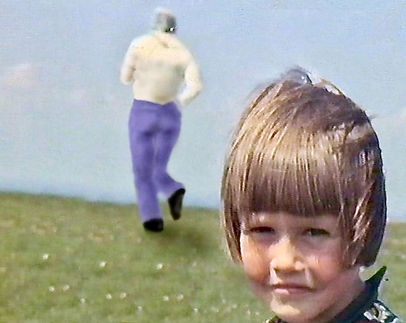
The photo is a classic optical effect. It is a misinterpretation of perspective by the brain that is caused by the angle of the subjects appearing in the photo. The figure is likely to be less than 5'10" and is jogging away from the camera at a 45 degree angle where the ground is sloping on an incline. Notice the angle of the right elbow in the original photo. It is angled in a way that is identical to the way that someone holds their arms when they are running away from you. The "spaceman" is not facing the camera, it is actually backside to the camera!
The off-balance posture is explained by the quick forward motion of the figure maneuvering up a hill. The light white-colored jacket or blouse that the figure is wearing is "inflated" by the breeze of forward motion. The Templeton girl's hair wisps are moving in the same direction that the wind is blowing onto the jogger. The image captured of the "spaceman" is indistinct because the jogger is moving with speed and is in full motion.
Templeton was very focused on taking a nice picture of his beloved daughter, and his gaze was only through the camera's viewfinder. The figure passed by his field of view rapidly and thus the figure was never seen by Templeton. Daughter Elizabeth had her back towards the back of the figure, and never saw the passerby either. This is because Elizabeth was concentrating on making a nice pose for the picture. Recognizing that the father and daughter were taking a photo, the jogger never engaged them or acknowledged them, and tried quickly to run away from the framing of the shot. Think about it. We have all tried to dash and dodge to avoid appearing in someone's private picture. Or it could be that the runner is entirely unaware that Mr. Templeton was just about to take a picture of his daughter.
What appears to be the rear-view of a helmet may actually be a headscarf, very popular in the early 1960s. If it is a woman, she may also be sporting a French pleat hairdo which was also very popular at that time, where the hair is worn in an extreme blunt squared-off back (like a helmet).

If the figure is that of a male (as pictured in overlay above) the helmet-like back view may be of a middle-aged man's blunt "helmet hair" haircut. This overlay also illustrates well the role that perspective played in the Templeton photo.
The backside "helmet" distortion as seen in the original photo may also be further compounded by an "artifact" in the photo that is known by professional photo-analysts as a "bokeh" – a lens aberration that causes back figure blurring. It is exacerbated by forward or side-to-side motion (as found in jogging).
Whether or not this can be classified as a purposeful "hoax" is open to debate. Perhaps, like the barber Ralph Ditter, Templeton wanted to please his daughter with a mystery. It may also be a situation where Templeton just let things get "out of hand." The interest in the photos escalated. Templeton may have chosen to "ignore" the instructive solution that had been provided to him early on by the very man who had developed the photo for him, that "some idiot" had gotten in the way of a nice photo.
THE REX HEFLIN PHOTOS

At noon on August 3, 1965, highway maintenance inspector Rex Heflin was driving near the Santa Ana, CA freeway when he saw a UFO. He stopped his vehicle and from the window shot a series of four photos using the Polaroid camera he had in his car and used for work. He believed that the craft was a little over 200 feet away at an altitude of about 150 feet and that it was approximately 30 feet in diameter. The craft appears fairly well-defined, clearly-structured and dull metal in color.
On September 20, 1965, the Santa Ana Register published the photos. Later, a Project Blue Book investigator interviewed Heflin. Heflin told the officer that the previous day he had handed over his original Polaroids to a supposed representative from the North American Air Defense Command (NORAD). Heflin did not obtain the NORAD Colonel's name and apparently gave the man his original evidence with only a promise of return without getting anything in writing confirming its receipt.
The Heflin photos are one of Ufology's "sacred cows" and the images are believed by some to be definitive. Many believe that they show a strange aerial craft of some sort, perhaps ET or perhaps an experimental vehicle. The facts however are far more down-to-earth: Rex Heflin was a Hoaxer.
Heflin's photos have notably been researched by researcher Ann Druffel. Druffel has to some measurable degree made her research "claim to fame" on the Heflin saga. Heflin maintained a very close relationship with Druffel for many years, including up until his death (a point she emphasized on her own website). She single-handedly kept up interest in Rex over the years – and may have been one of the few females with a continuing presence in Rex's life.
The Heflin photos have been subjected to countless official investigations, and to both amateur and expert analysis, over many years. We can go back and forth on such fine points as to whether a line or string can be detected in the photos. We can argue if, under the vehicle, there is some sort of disruption of the ground or if there is some sort of emission. But the simple facts remain:
-
The Heflin photos were Polaroids, meaning there were no negatives.
-
Even the original Polaroids went "missing" for decades.
-
The pictures are "fuzzy grey" and of poor quality and resolution.
-
Early 1960s-era Polaroid instant cameras were very low-grade systems.


The disappointing result is that any technical analysis is going to suffer from these very major disadvantages. But I am not going to concentrate so much on the technical dynamics of the case. I am going to "step back" and review the human dynamics and "deeper background" of the case.
A basic yet critical question appears to never have been asked by investigators about the Heflin photos:
Did people in the area know about the photos before they were published in the local newspaper?
Yes they did. And one such person is Mr. Edward Riddle. Ed Riddle was a professional who was later employed as a senior-level technical writer, including for a leading Menlo Park, California electronics technologies company. But in the summer of 1965 Riddle was a young man who was employed by the local telephone company. In the lunch room, Riddle remembers, a fellow that Riddle described as being "in a jolly mood" had come into the company lunch room and had brought with him what Riddle would soon later clearly and instantly recognize as the "Heflin UFO photos."
Riddle recounts that the man had told him that "his neighbor he knew had rigged up a toy train wheel and some monofilament fishing line, hung them out of his truck window, shot them and would maybe just take them to the paper for some fun."
Riddle explained that he did not want to be a "spoil sport" but "jeez, a joke's a joke." He agreed it was time to come clean about what he knew. Given his professional station and that Riddle avoided coming forward on this for decades – and that he never sought or received any compensation or notoriety for this – it is highly likely that he is telling the truth as he remembers it.
Riddle continued with his story: Some time after he had seen the UFO "toy train wheel" photos at work, he saw them in the newspapers, just like he heard they might be. The story had soon become huge, it had become very big news. It was then that Riddle became conflicted and genuinely concerned. He thought that Heflin was affable enough, but Riddle said that he knew what he knew, now what to do? He went home and asked his family what they felt should be his next step. They disapproved of his telling anything. No need to get involved. It will die down and no one is getting hurt or anything. Why spoil one nice guy's fun? The other folks at the office felt they should say nothing. So Riddle held his tongue too.
Today his family supports Riddle coming forward with his revelation, and they confirm that it happened just as he said it did at the time. And Riddle has confirmed this story to reporter Amy Wilson of The Orange County Register for the record. He is 100% certain that the Heflin photos were shown to him prior to their publication – and that they were explained by Heflin's neighbor as a hoax using toy train wheels. He also detailed to her that he was still wrestling with "talking or not talking" about what he knew to be the truth about the Heflin incident.
Other old-timers have been a bit less forthcoming about Rex Heflin than Edward Riddle, but are still instructive. Using old and new telephone directories and other research resources, this author located a now-retired former Heflin neighbor who could also speak to all of this. The former neighbor, though hintful about Heflin, did not want his name publicized. But the old OC'er related that he knew that: "Rex was a good man, fun-loving. Now he liked toys and trains and such. You look at those photos real close and you'll see what I mean." The man would not engage further in the discussion. But what little he said tends to uncannily confirm Ed Riddle's recollection.
This "fun loving" aspect of Heflin's was even pointed out by his supporter and researcher Ann Druffel. According to Druffel, Kelson & Wood (JSE 2000 p. 593), Heflin "had an offbeat sense of humor and joked at times in a deadpan fashion, particularly when irritated."
And many years ago, researcher Stephen Black film-interviewed Heflin about the incident. Heflin may have given Black a "metaphorical clue" when Heflin admitted to Black that he enjoyed model making. Heflin even had a model railway in his modest home (which Black filmed).
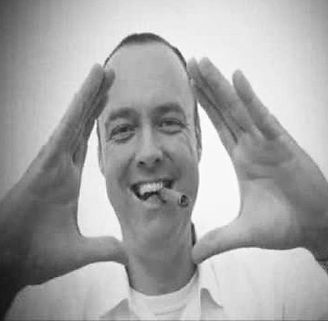
Rex Heflin, In the Spotlight
Heflin also made some "unusual" statements to Black early on. Heflin indicated that he was a Christian Scientist and explained to Black that "my religion doesn't let me recognize the laws of state." When asked if he was married, wifeless Heflin would only say, "More than once, but I don't want to refer to it on camera lest my five wives find out where I am." A strange man with a strange sense of humor.
Heflin's oddness and the persistent theme of trains and "toy wheels" resonated with me. And apparently it also has with other researchers. In 2006, researcher John Scheldroup reported in the UFO Updates forum that his photo enhancement and diagraming found that "a wheel of a model steam locomotive" had accounted for the Heflin "spaceship." He noted that "you can just make out the wheel hub protruding on the face of the wheel." UFO enthusiast Kyle King had done a similar matchup using various older toy train wheels and superimposing them onto the Heflin UFO image, producing highly suggestive matches.
Still others have come to similar conclusions. Another researcher indicated that he had conducted a graphic analysis of the Heflin photos.
He had secured an "O" Gauge model toy train wheel from a set of 3-Rail Andrews Trucks (Item #6033) by manufacturer Atlas O. He then digitally compared this toy train wheel with the Heflin "UFO" image using a Photoshop ImageReady animated gif program. He created a digital overlay comparison of the wheel onto the UFO image. It is not claimed that this is the very wheel Heflin had used, but it is highly persuasive that a toy wheel was just what the "UFO" was. The analyst adjusted the brightness and contrast and then applied a film grain filter for matching the two images. He indicates that he did not stretch or shrink the relative proportions of the "UFO" image to the train wheel image. Here are the striking results:

Blow-up of Heflin UFO
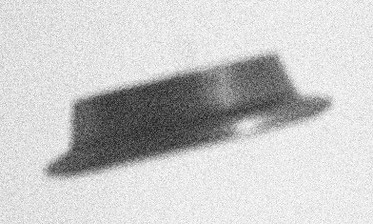
Screen Capture of Toy Train Wheel
Digitally Overlayed with Heflin UFO
And even though the Heflin photos at first seem somewhat impressive – they also seem damn terrestrial. The craft is so "plain" in its features that some had speculated it was not ET at all, but rather a secret Air Force experimental vehicle. But it is frankly not even as "interesting" as such a secret vehicle would appear.
And even less "spectacular" is Heflin's fourth and less-shown photo. It is less-shown probably because it is simply a smoke ring, likely from an air show:
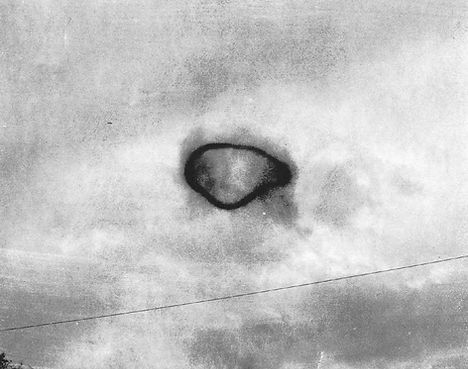
Heflin's "UFO" Smoke Ring Photo

Air Show Smoke Ring at Base
Very telling is that Heflin's community of Orange County has been home to such air shows for decades. In fact, an Annual Air Show is performed at the El Toro Marine Base Air Station every year. And El Toro is the very base that is located just one-half mile from where Heflin claimed his UFO sighting! Other nearby air shows are held regularly at Miramar Air Show, the Orange County Air Show and many others throughout Southern California.
In 1993, Heflin, by then a footnote, reinvigorated interest in his case. Heflin claimed that, after more than a quarter century had passed, the original Polaroid prints of his UFO had been mysteriously returned to him! Yes, the very photos that were confiscated by the MIBs from NORAD decades prior had finally been given back. Heflin said that he had received a phone call from an unidentified female caller instructing him to go to his mailbox. She then hung up. Heflin did as the mystery lady told him to do. He found the photos in a manila envelope that had been placed in his mailbox without postage or identifying information. NORAD has consistently stated that they have never identified anyone who was ever sent to Heflin's home. It is rare when I believe that the US government is telling some UFO truth.
It will be recalled that barber Ralph Ditter had hoaxed his famous Zanesville, Ohio photos in 1966 – just a year after Heflin's photos had appeared in print nationwide. Ditter had used "wheels from a toy" to accomplish his fabrication. It is now apparent that Heflin did too.
Heflin led a lonely and quirky life. For over three decades he traveled thanklessly down the same hot California county highways, inspecting for proper road signage and for potholes. He wanted something more and he got it. Rex Heflin's toy train wheel will forever roll on and on...
THE WILLIAM RHODES 1947 PHOTOS
-
Rhodes was a self-taught scientist and self-important man who lied about his education and credentials. He told investigators that he possessed degrees from the esteemed institutions of George Washington University and Columbia University. Later inquiries determined that he was never awarded any such degrees.
-
When asked, he said that he had the diplomas but could not immediately produce them. Though Rhodes referred to himself in later years as a "problem-solving research physicist" in his papers, there has never been any evidence whatsoever that Rhodes possessed any accredited degree of any type from anywhere ever.
-
He had no steady job, but was employed as a piano player some nights a week at a night club.
-
Background checks with neighbors (conducted by OSI on behalf of AMC) indicated that Rhodes was pleasant, but an emotionally high-strung loner and highly egotistical.
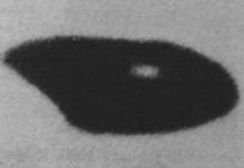
On July 7, 1947, William A. Rhodes took two photos of what he believed to be a "flying saucer" outside his home in Phoenix, Arizona. The photos were published in a local Phoenix newspaper with an accompanying story. Since then, the photos have been touted as an example of one of the earliest photos of the modern UFO era. But as with all cases, the "source" means everything. We must thoroughly examine the character of those making the claims. And when we apply this to William A. Rhodes, we learn that he was indeed a "character" not to be believed.
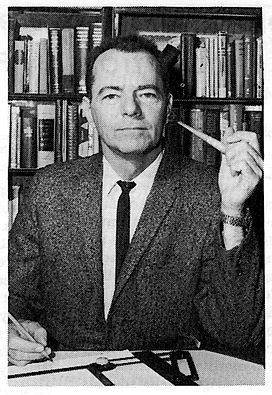
William A. Rhodes,
Posing Like a Professor
-
He had business cards printed up which read "Panoramic Research Laboratory", and he listed himself on the card as "Chief of Staff." But when government UFO investigators entered Rhodes' house to discuss his sighting, they realized that "Panoramic Research Laboratory" was in fact just a home-basement lab with very modest "equipment". The lab, they learned, had never conducted any "business" of any type with anyone. It turned out to be a place where Rhodes did "research experiments" to support his private hobby and avocation of acquiring as many US patents as he could in a number of wide-ranging areas. Rhodes acquired 30 such patents. But on closer examination we find that his patents are in such widely divergent areas that it becomes clear: Rhodes was barely a "jack of all trades" and most certainly he was a "master of none." One might say he was "scattered" in both work and in life.
-
The letterhead of his "lab" listed "Photography" as one of his specialties. But the photos taken of the "object" were taken by a cheap Brownie box camera, the negative was carelessly cut and cropped, faultily developed by Rhodes, and covered in streaks due to improper handling and storage. In the same way that Rex Heflin could not access his original Polaroids of the craft, Rhodes told investigators that he "could not find" the negative to the second photo of the heeled object. The result were barely recognizable photos that reproduced poorly with no frame of reference. In fact, in reproducing them, they are often placed traveling in different directions or even upside down! There is obviously a huge disconnect. A "scientist" who had as one of his "specialties" providing photographic services, who then captured a shot of an ET craft, would not handle such evidence so cavalierly.
Researcher Tom Carey believes that a likely candidate for this heel-shaped "UFO" was in fact a real heel. The heel of a shoe! The "Cat's Paw" heel and heel repair products were very popular in the late 1940s. One of the products touted a "plug" in the heel for added comfort. It may appear in the Rhodes photo as the "white spot" or "canopy" of the "UFO". Rhodes, as a piano player, probably had well-worn heels:
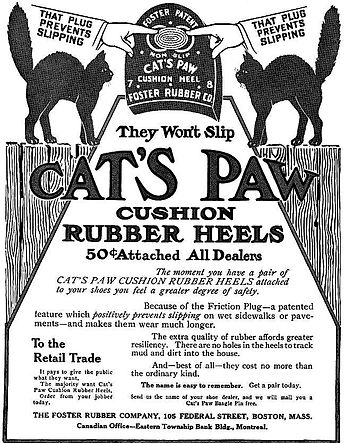
WHY THE HOAXES?
Why do people hoax UFO photos? Of course the answer to that is manifold. There are as many reasons for taking such pictures as there are people who take them. But when we eliminate the obviously-made-for-money hoaxes, we find some common denominators:
A desire to please is one. Barber Ralph Ditter wanted to impress his daughter with a promised UFO photo. Amateur photographer and fireman Jim Templeton was proud of his daughter too. If they could spread some wonder by allowing a little magic in a photo, so be it.
A desire to impress is another. William Rhodes was brilliant but uncredentialed. Like Rex Heflin, he was a lonely man. Patents and UFO photos would gain Rhodes the recognition that he felt that he deserved.
A desire to just have some plain old fun is often at the heart of it. We all know a practical joker. Perhaps you are one. Some enjoy a mischievous trick or joke that is played on others. It appeals to some people's sense of entertainment – and some will go pretty far for the "thrill". Ultimately such "punking" and fakery appeals to those who crave an activity that will divert, amuse or stimulate them on some level that they can't get in other ways. It's also "secret" and remains their secret. In some way this "empowers" them over others in ways that are known only to themselves.
Usually of course the intention is harmless. The intent is not to deceive the public in a grand way. Sometimes it just gets out of hand. Sometimes it just goes too far. Too many people get too involved and the ball keeps rolling and you just can't stop it. So you go with it. Until you are stopped by the Truth.
